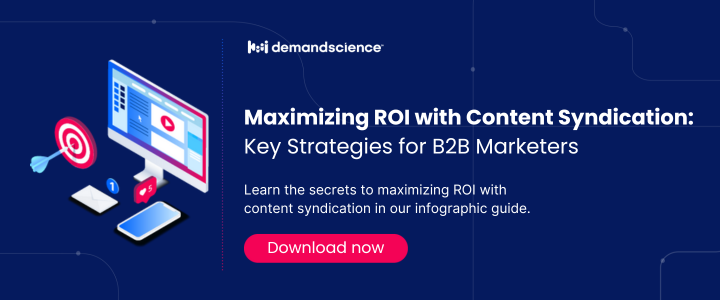
For every successful marketing strategy, several core tactics help tick key requirements off the list. In terms of the lead generation component, you can’t go wrong with content syndication.
Content syndication is the process of distributing your content, such as blogs, articles, or videos, to third-party websites or platforms for increased visibility and reach. When done correctly, content syndication can help you generate leads by driving targeted traffic to your website and increasing brand awareness.
How Content Syndication Gets People in Your Pipeline
Strategic content syndication drives targeted traffic. With quality data, content syndication is more than just a content distribution strategy; it is a lead generation tool that brings targeted traffic to your website or landing page, increasing the chances of conversion. Strategically distributing your content on channels where your target audience is most active attracts qualified leads genuinely interested in the solutions or information you offer.
And you get exposed to a new audience, along with backlinks to your own website, which also helps boost your SEO rank and drives more organic traffic. It can also bolster your database and pipeline as new leads.
Offer valuable gated content, such as ebooks, whitepapers, or webinars, to entice visitors to provide their contact details in exchange for access to the content. This allows you to build a database of leads who have shown a genuine interest in your offerings.
In theory, it’s straightforward. In practice, you have to consider at least three factors for content syndication to be an effective means of lead generation.
Factors to consider before using content syndication for lead generation
What is your content syndication strategy?
Your goals need to be very specific if you want to ensure you’re getting the results you want. For instance, if you want new leads that have never engaged with you before—top-of-the-funnel leads—you’ll likely be using broader and more general content. Start by determining what you want to achieve with content syndication. Is it increasing brand awareness, driving more traffic, generating leads, or all of the above? Clearly define your goals to guide your strategy.
On the other hand, if you want to better qualify leads you already have, you should zoom in and get more specific with the content you syndicate. For instance, you can address a common concern you’ve uncovered through interacting with your leads.
Your goals will also determine where you choose to syndicate.
For new leads, you’ll want to syndicate on popular, high-ranking websites that also reach your target audience. These could be companies in the same vertical industry as you are but aren’t direct competitors. Sites that aggregate industry news are another potential candidate for a content syndication partnership.
Once you have identified the platforms, choose the ones that align with your target audience and have a good reputation. Look for partners with a large and engaged audience and a strong track record of successful content syndication.
It works differently when you’re talking about qualifying existing leads. For that, you need a greater degree of control over the syndication process, something you won’t always get with third-party websites.
What kind of content can you produce?
The ability to produce quality content is crucial for lead generation. Quality content not only attracts and engages potential customers but also establishes credibility and trust. In today’s digital age, where competition is fierce, businesses need to stand out from the crowd and offer valuable content to capture the attention of their target audience.
Before content syndication-powered lead generation, you ought to make sure you are attracting the right audience. Quality content is tailored to the needs and interests of your target audience. By providing relevant and valuable information, you can attract the right people who are genuinely interested in your products or services. This not only increases the quantity of leads but also improves the quality of leads.
To ensure your content is suitable for syndication, create high-quality, evergreen content that provides value to your target audience. This includes articles, blog posts, infographics, videos, or podcasts. Make sure the content is well-researched, informative, and aligns with the interests of the syndication platforms’ audiences. Remember that when your content resonates with your audience, they are more inclined to share it with their network, expanding your reach and increasing the likelihood of generating leads.
Finally, do not forget to optimize your content for syndication. Format your content to be easily syndicated. This includes adding clear headlines, concise summaries, and relevant keywords. Incorporate social sharing buttons and trackable links to encourage further engagement and measure the success of your syndication efforts.
What kind of data are you getting back?
All content syndication arrangements should include reporting of some kind—beyond the actual lead information. Partnerships with other websites, for example, might readership numbers and perhaps even CTRs. If you choose to syndicate on social media, those platforms can report on likes, shares, comments, and clicks.
These lead generation metrics can give you a general idea of how your content is being received, but if you want data that will have an impact on your future marketing campaigns, you need more depth. Dedicated content syndication platforms provide that level of detail because they’re specifically designed to meet the needs of B2B companies looking to syndicate their content.
Take readership statistics, for example. At its most basic, they will tell you who read your content. What is far more useful, however, is knowing which section of your content they spent most of their time on. This level of specificity will clue you into what it is about your content that particularly interests them. You can then use this information as you begin nurturing your leads further—and they’ll appreciate getting content that is directly relevant to them.
Engagement is also a key consideration. Many websites that will syndicate your content won’t allow you to place a contact form directly within your content, because it may confuse their audience. At most, you’ll be able to include a link to your landing page. With dedicated syndication platforms, you can include contact forms as part of your content. This means you’ll be receiving data directly and will be able to act on it more quickly.

How are your leads getting qualified?
Another important piece of the data puzzle is, naturally, contact information for your leads. You get this from a lot of content syndication partners, but it’s usually in the form of a raw leads list, possibly with incomplete or even non-usable information.
Scoring and qualifying leads determine the quality and readiness of leads before investing time and resources into nurturing them.
Raw data isn’t much help when what you really want to know is who’s truly interested and even to what extent they’re ready to make a purchase. This allows you to focus your time and efforts on leads that have the highest likelihood of converting.
Scoring and qualifying leads allow you to prioritize your efforts and focus on those prospects who are most likely to convert. Assign scores based on their level of interest, engagement, and fit with your ideal customer profile, and identify the leads that are most likely to progress through the sales funnel.
With dedicated syndication partners, qualification begins during your content syndication campaign. You get dedicated quality assurance researchers who keep tabs on your campaign to make sure things remain on point per your goals. Additionally, they also verify and qualify the inbound leads for accuracy of information and relevance to your parameters, respectively.
This is no small thing because inactive and out-of-market leads tend to be a huge drain on your time and resources. With point-of-contact qualification, you get the added bonus of segmenting from the get-go—which can help expedite your further nurturing efforts. Lead scoring and qualification provides a common language and framework for marketing and sales teams to align their efforts. This collaboration leads to better lead handoff, improved communication, and ultimately higher conversion rates.
Optimizing your syndicated content for lead generation
Optimizing your syndicated high-quality content for lead generation is crucial to the success of your content syndication strategy. After all, the ultimate goal of this tactic is to drive more potential customers back to your website and convert them into leads.
One effective way to optimize your syndicated content for lead generation is to include clear and compelling calls-to-action (CTAs). These CTAs should be strategically placed throughout your content, encouraging your readers to take a specific action, such as downloading a whitepaper, signing up for a newsletter, or requesting a consultation.
Another important element to consider is lead capture forms. By integrating lead capture forms within your syndicated content, you can collect valuable information about your readers, such as their name, email address, and job title. This data can then be used to nurture these leads and move them further down the sales funnel.
It’s also important to ensure that your syndicated content is optimized for mobile devices. With more and more people consuming content on the go, it’s essential that your content is easy to read and interact on with smaller screens. This may involve adjusting the layout, font size, and overall user experience to provide a seamless experience for your mobile audience.
Finally, don’t forget to incorporate relevant keywords and phrases throughout your syndicated content. This will not only help improve the SEO of your content, but it will also make it more discoverable by your target audience as they search for information related to your products or services.
- Leverage gated content: Offer valuable, gated content, such as industry reports, whitepapers, or webinars, in exchange for the reader’s contact information. This allows you to capture lead data and nurture those leads through your sales funnel.
- Incorporate lead capture forms: Embed lead capture forms directly within your syndicated content, making it easy for readers to provide their contact information and express interest in your products or services.
- Promote lead magnets: Create compelling lead magnets, such as checklists, eBooks, or video tutorials, and promote them through your syndicated content. This helps to attract and convert readers who are interested in your expertise and offerings.
- Utilize retargeting: Leverage display ads to stay top-of-mind with readers who have interacted with your syndicated content. This can help to nurture those leads and encourage them to take further action, such as visiting your website or scheduling a consultation.
- Integrate with your CRM: Ensure that the leads generated through your content syndication efforts are seamlessly integrated with your customer relationship management (CRM) system. This allows you to effectively manage and nurture those leads, ultimately driving more conversions.
- Personalize the experience: Tailor your content and lead capture mechanisms to the specific interests and pain points of your target audience. This personalized approach can help to increase the relevance and effectiveness of your lead generation efforts.
- Leverage influencer partnerships: Collaborate with industry influencers or thought leaders to co-create and syndicate content. This can help to expand your reach, enhance your credibility, and generate leads from the influencer’s engaged audience.
- Optimize for mobile: Ensure that your syndicated content and lead capture forms are optimized for mobile devices, as an increasing number of your target audience may be accessing your content on the go.

Content Syndication That Doesn’t Suck
Better Leads Through Content Syndication
Content syndication will bolster your lead-generation efforts. It lets you speak directly to your target audience, clues you into what that audience is responding to, and gives you the opportunity to further qualify leads based on how likely they are to buy from you. If you want to make the most of your content syndication campaigns, make sure you have the right answers to these three key considerations.
Read more about how to convert syndication leads here.
Better Content Syndication Begins with DemandScience
With DemandScience’s syndication solution, you gain all the advantages of a dedicated syndication platform. Based on your exact specifications, we can build a list for you from over 200 million verified B2B buyers from all industries across the globe—even expanding your reach with look-alike lists. We place your best content in front of those most interested, and carefully track and monitor key points that indicate intent to purchase.










